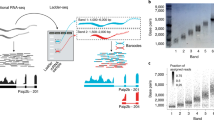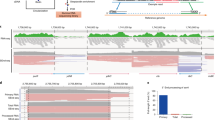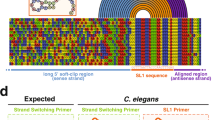Abstract
Deep sequencing of 'transcriptomes' — the collection of all RNA transcripts produced at a given time — from worms to humans reveals that some transcripts are composed of sequence segments that are not co-linear, with pieces of sequence coming from distant regions of DNA, even different chromosomes. Some of these 'chimaeric' transcripts are formed by genetic rearrangements, but others arise during post-transcriptional events. The 'trans-splicing' process in lower eukaryotes is well understood, but events in higher eukaryotes are not. The existence of such chimaeric RNAs has far-reaching implications for the potential information content of genomes and the way it is arranged.
This is a preview of subscription content, access via your institution
Access options
Subscribe to this journal
Receive 51 print issues and online access
$199.00 per year
only $3.90 per issue
Buy this article
- Purchase on Springer Link
- Instant access to full article PDF
Prices may be subject to local taxes which are calculated during checkout




Similar content being viewed by others
References
Mercer, T. R., Dinger, M. E. & Mattick, J. S. Long non-coding RNAs: insights into functions. Nature Rev. Genet. 10, 155–159 (2009).
Ponting, C. P., Oliver, P. L. & Reik, W. Evolution and functions of long noncoding RNAs. Cell 136, 629–641 (2009).
ENCODE Project Consortium. Identification and analysis of functional elements in 1% of the human genome by the ENCODE pilot project. Nature 447, 799–816 (2007).
Celniker, S. E. et al. Unlocking the secrets of the genome. Nature 459, 927–930 (2009).
Carninci, P. et al. The transcriptional landscape of the mammalian genome. Science 309, 1559–1563 (2005).
Jones, P. A. et al. Moving AHEAD with an international human epigenome project. Nature 454, 711–715 (2008).
Hert, D. G., Fredlake, C. P. & Barron, A. E. Advantages and limitations of next-generation sequencing technologies: a comparison of electrophoresis and non-electrophoresis methods. Electrophoresis 29, 4618–4626 (2008).
Ramadan, N., Flockhart, I., Booker, M., Perrimon, N. & Mathey-Prevot, B. Design and implementation of high-throughput RNAi screens in cultured Drosophila cells . Nature Protocols 2, 2245–2264 (2007).
Amaral, P. P. & Mattick, J. S. Noncoding RNA in development. Mamm. Genome 19, 454–492 (2008).
Mattick, J. S., Amaral, P. P., Dinger, M. E., Mercer, T. R. & Mehler, M. F. RNA regulation of epigenetic processes. Bioessays 31, 51–59 (2009).
Cooper, T. A., Wan, L. & Dreyfuss, G. RNA and disease. Cell 136, 777–793 (2009).
Ashe, A. & Whitelaw, E. Another role for RNA: a messenger across generations. Trends Genet. 23, 8–10 (2007).
Sutton, R. E. & Boothroyd, J. C. Evidence for trans splicing in trypanosomes. Cell 47, 527–535 (1986).
Krause, M. & Hirsh, D. A trans-spliced leader sequence on actin mRNA in C. elegans . Cell 49, 753–761 (1987).
Tessier, L. H. et al. Short leader sequences may be transferred from small RNAs to pre-mature mRNAs by trans-splicing in Euglena . EMBO J. 10, 2621–2625 (1991).
Rajkovic, A., Davis, R. E., Simonsen, J. N. & Rottman, F. M. A spliced leader is present on a subset of mRNAs from the human parasite Schistosoma mansoni . Proc. Natl Acad. Sci. USA 87, 8879–8883 (1990).
Davis, R. E. et al. RNA trans-splicing in Fasciola hepatica. Identification of a spliced leader (SL) RNA and SL sequences on mRNAs. J. Biol. Chem. 269, 20026–20030 (1994).
Li, X., Zhao, L., Jiang, H. & Wang, W. Short homologous sequences are strongly associated with the generation of chimeric RNAs in eukaryotes. J. Mol. Evol. 68, 56–65 (2009). This paper includes computational analyses of human, mouse and fly RNA databases to identify chimaeric RNAs and short repeat sequences located at the junction sites forming the chimaeric transcripts.
Li, H., Wang, J., Mor, G. & Sklar, J. A neoplastic gene fusion mimics trans-splicing of RNAs in normal human cells. Science 321, 1357–1361 (2008). This paper identifies chimaeric RNA and protein from JAZF1 and JJAZ1 genes in normal and transformed endometrial cells.
Eychene, A., Rocques, N. & Pouponnot, C. A new MAFia in cancer. Nature Rev. Cancer 8, 683–693 (2008).
Rickman, D. S. et al. SLC45A3–ELK4 is a novel and frequent erythroblast transformation-specific fusion transcript in prostate cancer. Cancer Res. 69, 2734–2738 (2009). This paper identifies chimaeric RNA from the SLC45A3 and ELK4 genes in normal and transformed prostate cells.
Janz, S., Potter, M. & Rabkin, C. S. Lymphoma- and leukemia-associated chromosomal translocations in healthy individuals. Genes Chromosomes Cancer 36, 211–223 (2003).
Maher, C. A. et al. Transcriptome sequencing to detect gene fusions in cancer. Nature 458, 97–101 (2009).
Denoeud, F. et al. Prominent use of distal 5′ transcription start sites and discovery of a large number of additional exons in ENCODE regions. Genome Res. 17, 746–759 (2007). This paper identifies and characterizes chimaeric RNAs in normal tissue and transformed cell lines mapping in the 1% of the human genome analysed by the ENCODE studies.
Djebali, S. et al. Efficient targeted transcript discovery via array-based normalization of RACE libraries. Nature Methods 5, 629–635 (2008).
Akiva, P. et al. Transcription-mediated gene fusion in the human genome. Genome Res. 16, 30–36 (2006).
Parra, G. et al. Tandem chimerism as a means to increase protein complexity in the human genome. Genome Res. 16, 37–44 (2006).
Kapranov, P. et al. Examples of the complex architecture of the human transcriptome revealed by RACE and high-density tiling arrays. Genome Res. 15, 987–997 (2005).
Bruzik, J. P. & Maniatis, T. Spliced leader RNAs from lower eukaryotes are trans-spliced in mammalian cells. Nature 360, 692–695 (1992).
Bruzik, J. P. & Maniatis, T. Enhancer-dependent interaction between 5′ and 3′ splice sites in trans . Proc. Natl Acad. Sci. USA 92, 7056–7059 (1995).
Coffin, J. M. Structure, replication, and recombination of retrovirus genomes: some unifying hypotheses. J. Gen. Virol. 42, 1–26 (1979).
Hastings, K. E. SL trans-splicing: easy come or easy go? Trends Genet. 21, 240–247 (2005).
Jackson, D. A., Hassan, A. B., Errington, R. J. & Cook, P. R. Visualization of focal sites of transcription within human nuclei. EMBO J. 12, 1059–1065 (1993).
Mitchell, J. A. & Fraser, P. Transcription factories are nuclear subcompartments that remain in the absence of transcription. Genes Dev. 22, 20–25 (2008).
Pombo, A. & Cook, P. R. The localization of sites containing nascent RNA and splicing factors. Exp. Cell Res. 229, 201–203 (1996).
Pombo, A. et al. Regional and temporal specialization in the nucleus: a transcriptionally-active nuclear domain rich in PTF, Oct1 and PIKA antigens associates with specific chromosomes early in the cell cycle. EMBO J. 17, 1768–1778 (1998).
Carter, D. R., Eskiw, C. & Cook, P. R. Transcription factories. Biochem. Soc. Trans. 36, 585–589 (2008).
Osborne, C. S. et al. Myc dynamically and preferentially relocates to a transcription factory occupied by Igh PLoS Biol. 5, e192 (2007).
Dostie, J., Zhan, Y. & Dekker, J. Chromosome conformation capture carbon copy technology. Curr. Protocols Mol. Biol. Ch. 21, 14 (2007).
Margulies, E. H., Program, N. C. S. & Green, E. D. Detecting highly conserved regions of the human genome by multispecies sequence comparisons. Cold Spring Harb. Symp. Quant. Biol. 68, 255–263 (2003).
Margulies, E. H. et al. An initial strategy for the systematic identification of functional elements in the human genome by low-redundancy comparative sequencing. Proc. Natl Acad. Sci. USA 102, 4795–4800 (2005).
Margulies, E. H. et al. Analyses of deep mammalian sequence alignments and constraint predictions for 1% of the human genome. Genome Res. 17, 760–774 (2007).
Brudno, M. et al. LAGAN and Multi-LAGAN: efficient tools for large-scale multiple alignment of genomic DNA. Genome Res. 13, 721–731 (2003).
Cooper, G. M. et al. Characterization of evolutionary rates and constraints in three mammalian genomes. Genome Res. 14, 539–548 (2004).
Siepel, A. et al. Evolutionarily conserved elements in vertebrate, insect, worm, and yeast genomes. Genome Res. 15, 1034–1050 (2005).
Kiemeney, L. A. et al. Sequence variant on 8q24 confers susceptibility to urinary bladder cancer. Nature Genet. 40, 1307–1312 (2008).
Yeager, M. et al. Genome-wide association study of prostate cancer identifies a second risk locus at 8q24. Nature Genet. 39, 645–649 (2007).
Altshuler, D., Daly, M. J. & Lander, E. S. Genetic mapping in human disease. Science 322, 881–888 (2008).
Acknowledgements
Work in my laboratory is supported by the National Human Genome Research Institute (grants U54 HG004557 and U01 HG004271). I thank P. Kapranov for discussions and long-term collaboration, H. Sussman for helpful discussions and editing of the manuscript, and A. Dobin for help deriving the computational expressions to determine the co-linear and non-co-linear permutations, and for the plot shown in Fig. 4c.
Author information
Authors and Affiliations
Ethics declarations
Competing interests
T.R.G. was an employee of Affymetrix at the same time as some of the studies cited in this Review used its microarray technology.
Additional information
Reprints and permissions information is available at http://www.nature.com/reprints.
Correspondence should be addressed to T.R.G. (gingeras@cshl.edu).
Rights and permissions
About this article
Cite this article
Gingeras, T. Implications of chimaeric non-co-linear transcripts. Nature 461, 206–211 (2009). https://doi.org/10.1038/nature08452
Published:
Issue Date:
DOI: https://doi.org/10.1038/nature08452
This article is cited by
-
Genes that are Used Together are More Likely to be Fused Together in Evolution by Mutational Mechanisms: A Bioinformatic Test of the Used-Fused Hypothesis
Evolutionary Biology (2023)
-
Profiling of somatic mutations and fusion genes in acute myeloid leukemia patients with FLT3-ITD or FLT3-TKD mutation at diagnosis reveals distinct evolutionary patterns
Experimental Hematology & Oncology (2021)
-
Identification of the cross-strand chimeric RNAs generated by fusions of bi-directional transcripts
Nature Communications (2021)
-
Fusion transcripts in normal human cortex increase with age and show distinct genomic features for single cells and tissues
Scientific Reports (2020)
-
Evidence of constraint in the 3D genome for trans-splicing in human cells
Science China Life Sciences (2020)
Comments
By submitting a comment you agree to abide by our Terms and Community Guidelines. If you find something abusive or that does not comply with our terms or guidelines please flag it as inappropriate.



